The guitars Carbonetti builds are unlike anything else you’ve seen, and while each one is made bespoke for the client who ordered it, they all share Carbonetti’s old world-informed building fundamentals and unique aesthetic touch – which strikes an impossibly cool balance between the timeless and the utterly whimsical.
For guitar aficionados with an eye that’s been trained to exclusively appreciate the visual queues of the classic Fender and Gibson designs that have gone essentially unchanged since their inception, the guitars Carbonetti hand-shapes (there are no CNC blanks involved here and he even winds his own pickups) in his Sunset Park, Brooklyn operation can feel completely unexpected and even jarring at first. However, for celebrated players like Guns N’ Roses’ Richard Fortus, mega-producer/guitarist Matt Sweeney (Iggy Pop, Chavez), and the Black Crowes’ Rich Robinson, Carbonetti’s refreshing designs aren’t just eye candy for the studio wall, but trusted and inspirational tone tools that have often made their way to stadium stages and iconic recordings.
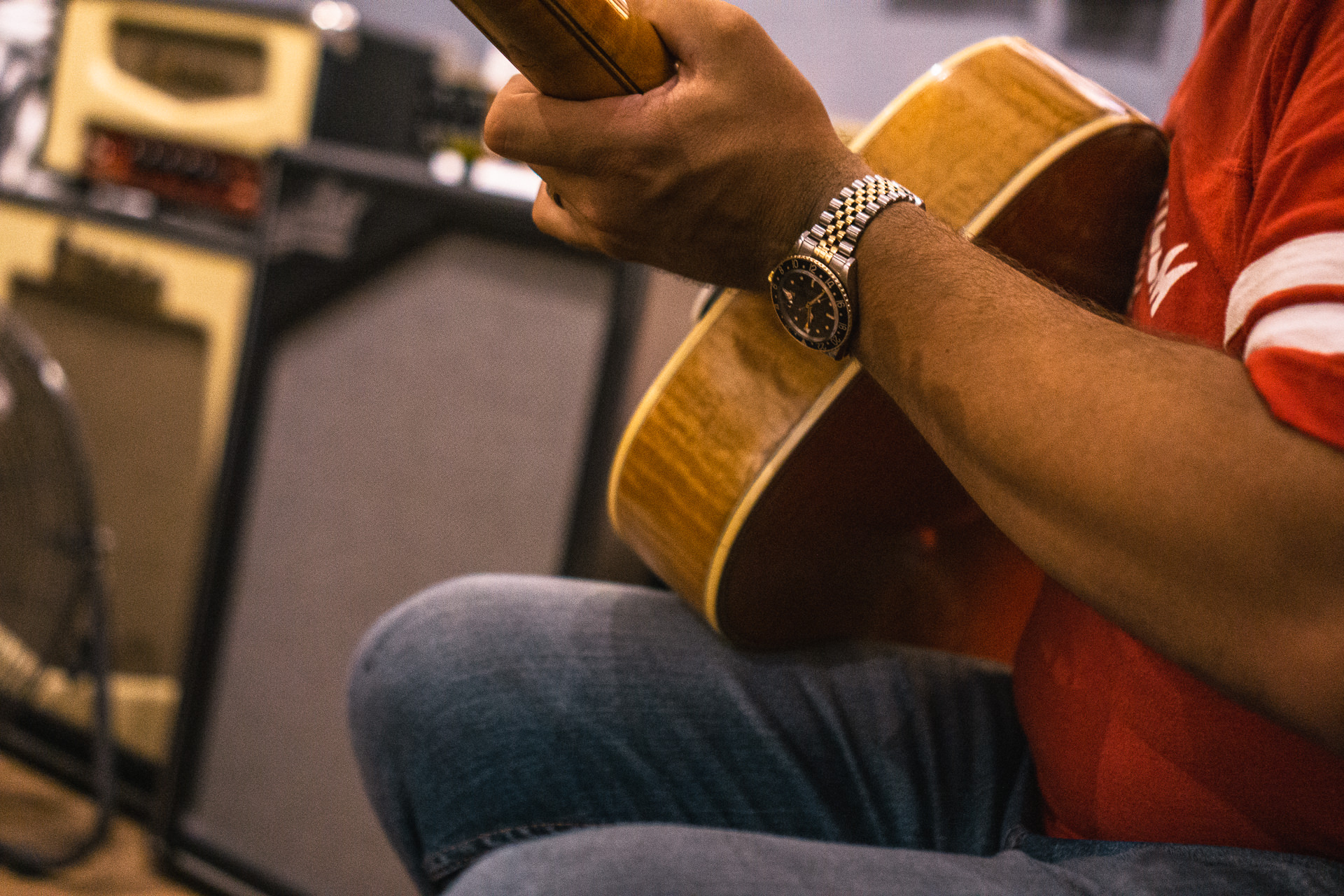
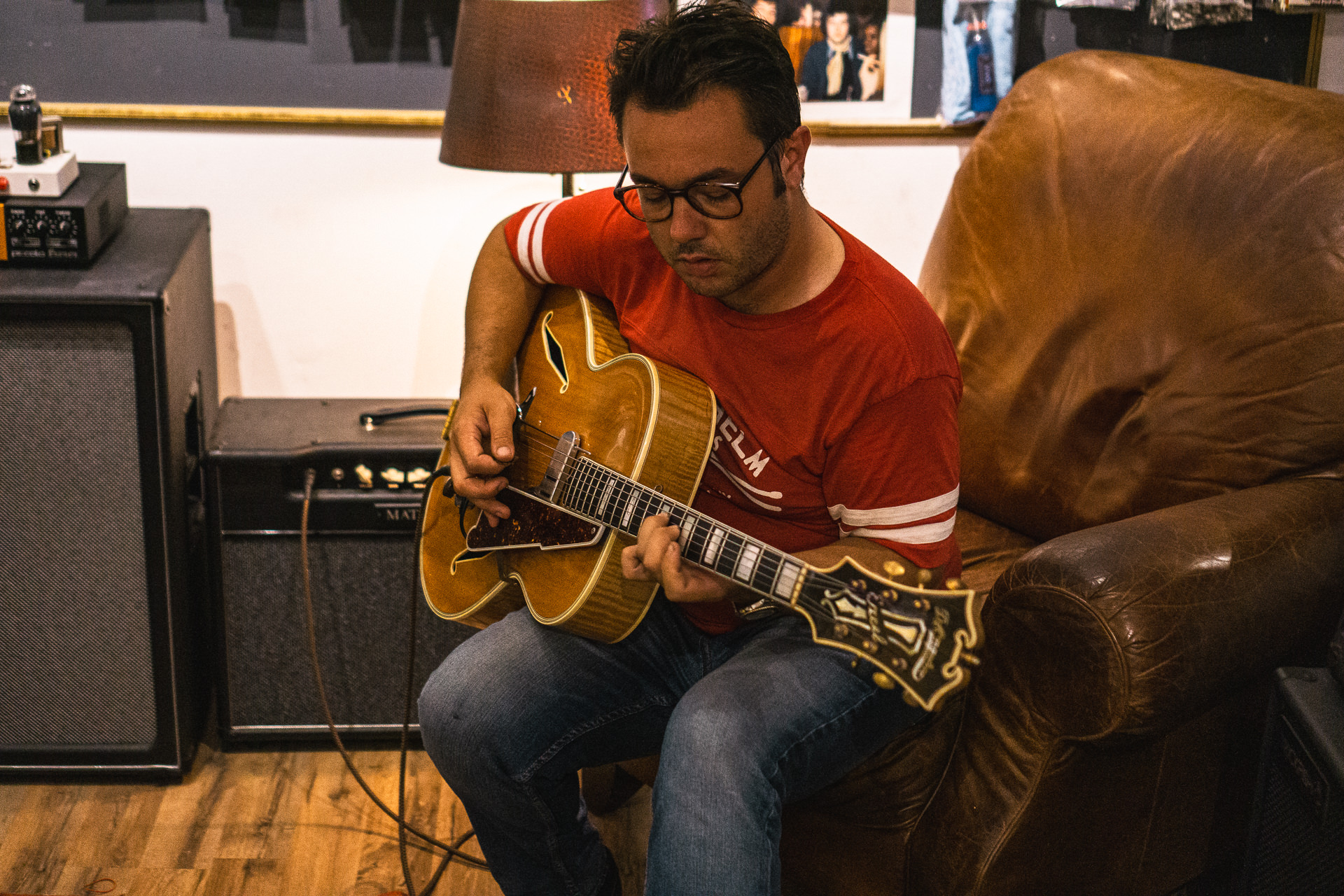
In addition to the handmade guitars that have seen Carbonetti’s star rise in recent years, he’s an important member of the legendary NYC-based La Bella String company family, and has also recently become an unexpected collaborator with Toulon/Odyssey Golf, with whom he’s crafted a series of limited edition putters that combine his woodworking skills with Toulon’s high performance golf tech to make for something wholly unique.
For Carbonetti, it’s all about pursuing his various passions as a true student of them. Whether it’s chasing the ghost of famed NYC archtop godhead John D’Angelico or bringing something unseen to the golf world, Carbonetti throws himself deeply into whatever it is that’s captured his imagination on a given week and is exactly the kind of obsessive we here at C + T relate to the most. So, it should be unsurprising that Carbonetti is also a serious watch nerd and Rolex devotee, and that he’s rarely found without his beloved 1980 two-tone GMT-Master on-wrist – even when he’s making sawdust with a belt sander. Carbonetti’s path into the vintage watch world is also unexpected and came through the vintage guitar world, but proves there are as many paths into the hobby as there are reference numbers.
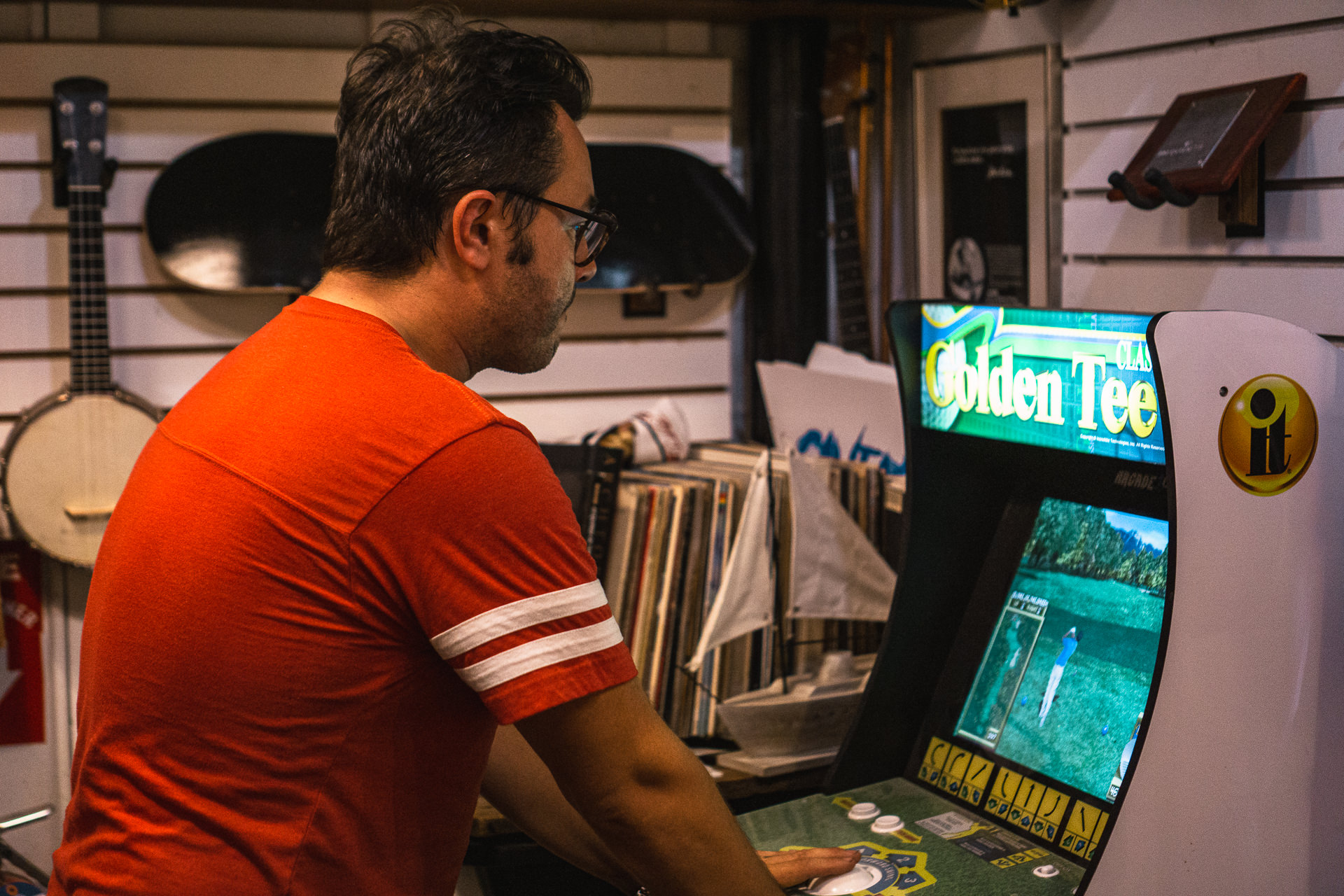
In the following interview, Jimmy Carbonetti walks us through his entry into the bespoke guitar world through the vintage guitar space, explains his philosophy as a builder and enthusiast, riffs on his love of GMTs and golf, and tells the tale of his incredibly rare 1938 D’Angelico Excel, a guitar originally ordered by famed mobster James “Jimmy Nap” Napoli and a guitar that’s been Carbonetti’s grail for a decade.
Your custom guitars have a bespoke flair to them and don’t look like anything else I’ve ever seen. How’d you get started building custom guitars? I know you were in the vintage guitar business first.
Yeah, as a sales and repair guy. I started at Chelsea Guitars, which was the best place in NYC to learn about vintage stuff at the time. It was full of crazy characters and Danny Courtney and Doug Myer, who now owns Mountain Cat Guitars, taught me tons of shit. I got to hang out with people like GE Smith from the SNL band, and had all these characters telling me what to listen to and how to deal with the vintage guitar world. It’s been 12 years with the custom guitars and it’s been great being able to make weird guitars that I love. I feel like every one that I’ve made is one I’d keep for myself – so it’s a real expression of my personality, too.
How old were you when you started?
I was 18 when I started there. I had been working in Georgio Gomelsky’s studio; he was the original manager and producer of the Yardbirds and also managed the Stones for a while. I worked at his rehearsal space on 26th street and he got me to the job at Chelsea Guitars. He was like “You love guitars, you should be working here” and got me in. I was working there at the tail end of the craziness of the real Chelsea Hotel, right before it started switching hands and had seven different owners who tried to make it a boutique hotel.
After I left Chelsea Guitars, I started Cobra Guitars in 2009 with my buddy Eli Apollo and I built those for a few years. Eli has Lucky Lady Vintage Guitars in Austin now, so he’s become a private dealer. We split up amicably and he’s a great dude, so that was all good, and I started Carbonetti Guitars after that.
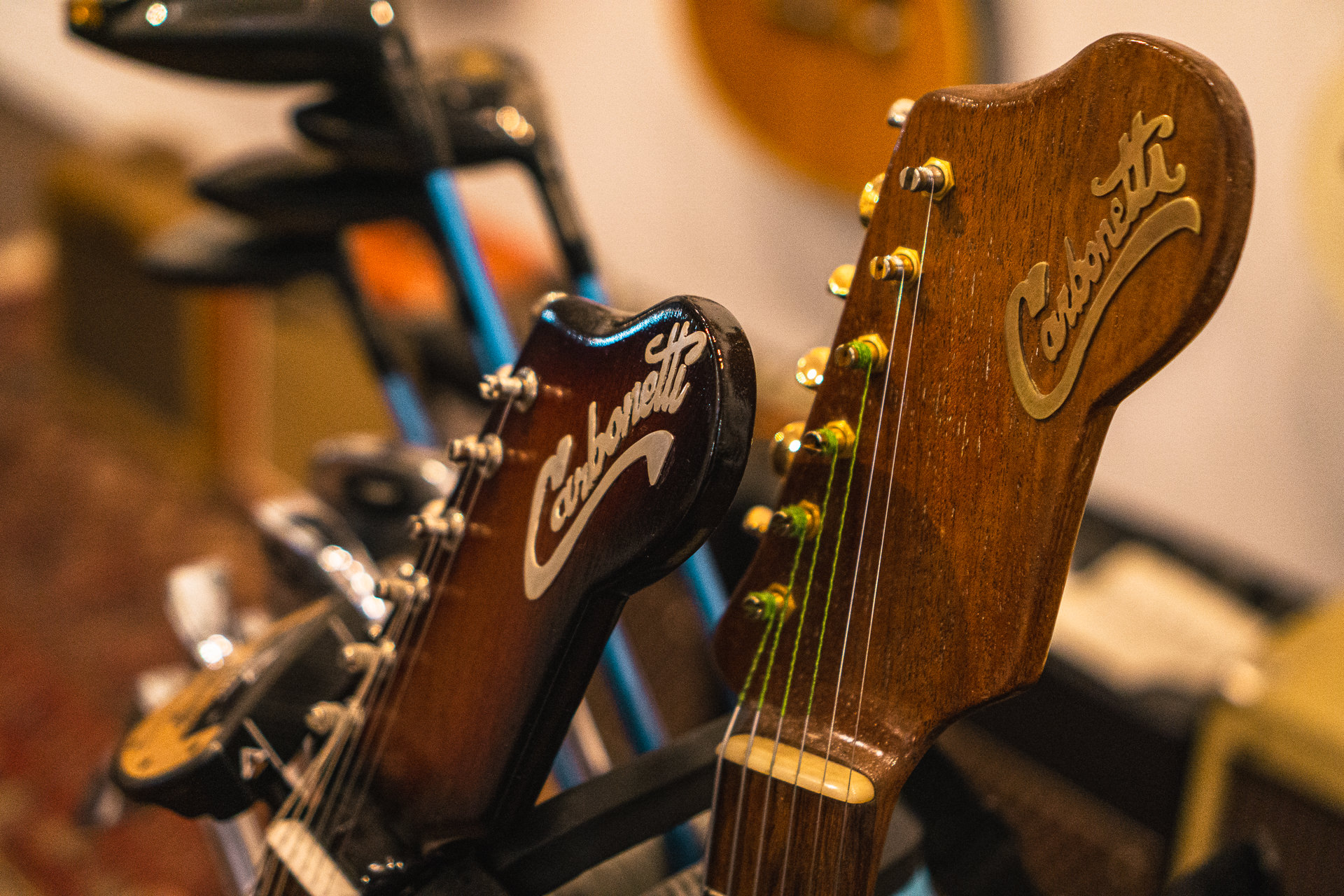

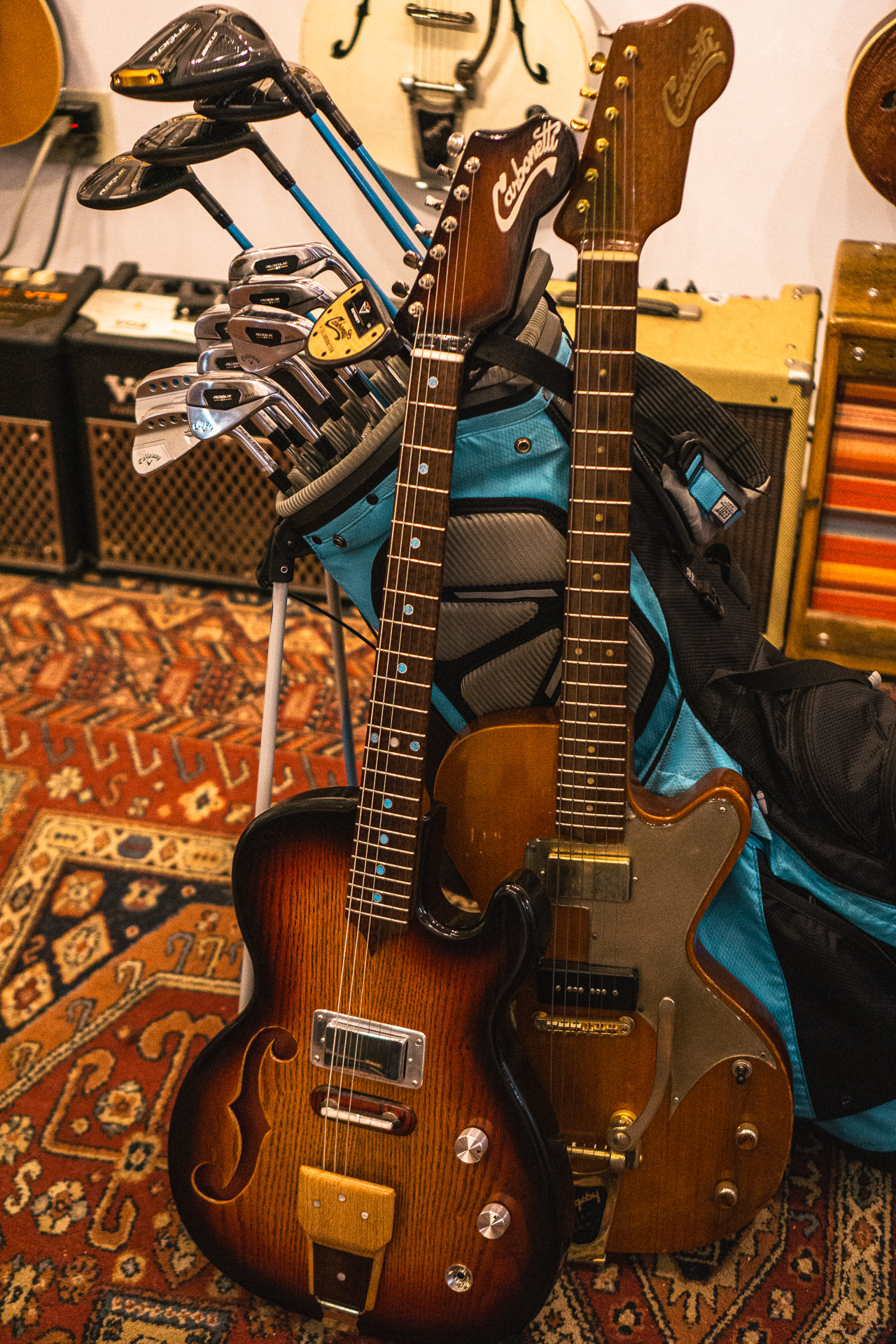
The Cobra guitars were more traditional and some of them ended up in famous hands. I know Chris Greatti uses the Strat-style you built him a lot still with major pop artists.
We did about 50 Cobras, all one-of-a-kind. After we ended that venture, I went from using my nickname to my last name in 2015. Chris Traynor from Bush has a Cobra he uses a lot, as does Gavin Rossdale. Those were made right off of my experience in the vintage guitar world and were influenced by the classics, but I just wanted to get weird with it. It was always my version, with a weird headstock and things that didn’t fall in-line with trying to make a replica of a vintage guitar.
Why did you decide to shift to the Carbonetti line when you killed the Cobra name? Are the unique designs you make now an opposite reaction to what you were making before?
A little bit. Most builders cut their teeth on Strats and Teles and that’s the easiest way to get into this, but from pretty early on, I wanted to make it the most fucked up version of those designs that I could. I love guitars that have a story; hopefully that story is that it’s been on tour for 40 years and been played to death. So to make a guitar that evoked that, the Cobra guitars had to be overly cool and beat up in some way to get over the fact that at the end of the day, it was still just a Tele or a Strat.
When I started Carbonetti Guitars, I wanted to run away from that and I wanted to make guitars more like a ‘50s Rolls Royce: Something that’s been taken care of and not overly beat up. They look old, they look worn a bit, but they’re not all dinged up and destroyed. I’ll still make a heavily relic’d guitar if that’s what it needs to feel right, but overall, I want to make something that looks like an Italian guy made it in the ‘60s while trying to figure out what the future would look like. A little classy, a little homemade, a little whimsical.

They have a very charming handmade, almost woodshop vibe to them. They project a deliberate image of imperfection.
That’s my favorite thing. It’s a scrappy, woodshop thing that I want to give the same feeling you get when you look at old D’Angelico guitars. They’re not perfect, but that’s what makes ’em perfect! You can tell someone made them by hand with a lot of care. That’s my ultimate goal.
Even with watches – and it depends on the watch because Rolexes are just perfect in how they’re made – but I like watches that show that they’ve lived a life. I love the aged gilt dials or just how these things develop patina over time.
When you shifted away from the more traditional guitar styles you did with the Cobra line, did you experience much kickback from your customers? Were people weird about ordering guitars so far outside the normal standards of guitar design?
No, quite the opposite! I feel like I found myself as a builder and people are really into that thing. When I get an order, a lot of the details on my guitars are chef’s choice, which is really cool. I feel very honored that people trust me with that kind of stuff. A customer and I will go through the tones they want and we’ll pick woods together, and since I wind my own pickups, I can really dial things in. But I find that often my customers will say “I want that idea, but do your thing.” Since I paint them with lacquer myself and I mix all my own pigments and I hand-carve necks, there’s a lot of freedom for me as a luthier. They’ll always have that handmade feel. I don’t measure my necks and I don’t know if it’s a perfect C or perfect D shape, I just hold it and I close my eyes and I just feel it until I can say “All right, that’s nice.” A lot of times, I’ll have the customer come in when I’m shaping a neck and we’ll just go back-and-forth until it feels right to their hands. It’s like a bespoke, custom-tailored suit.
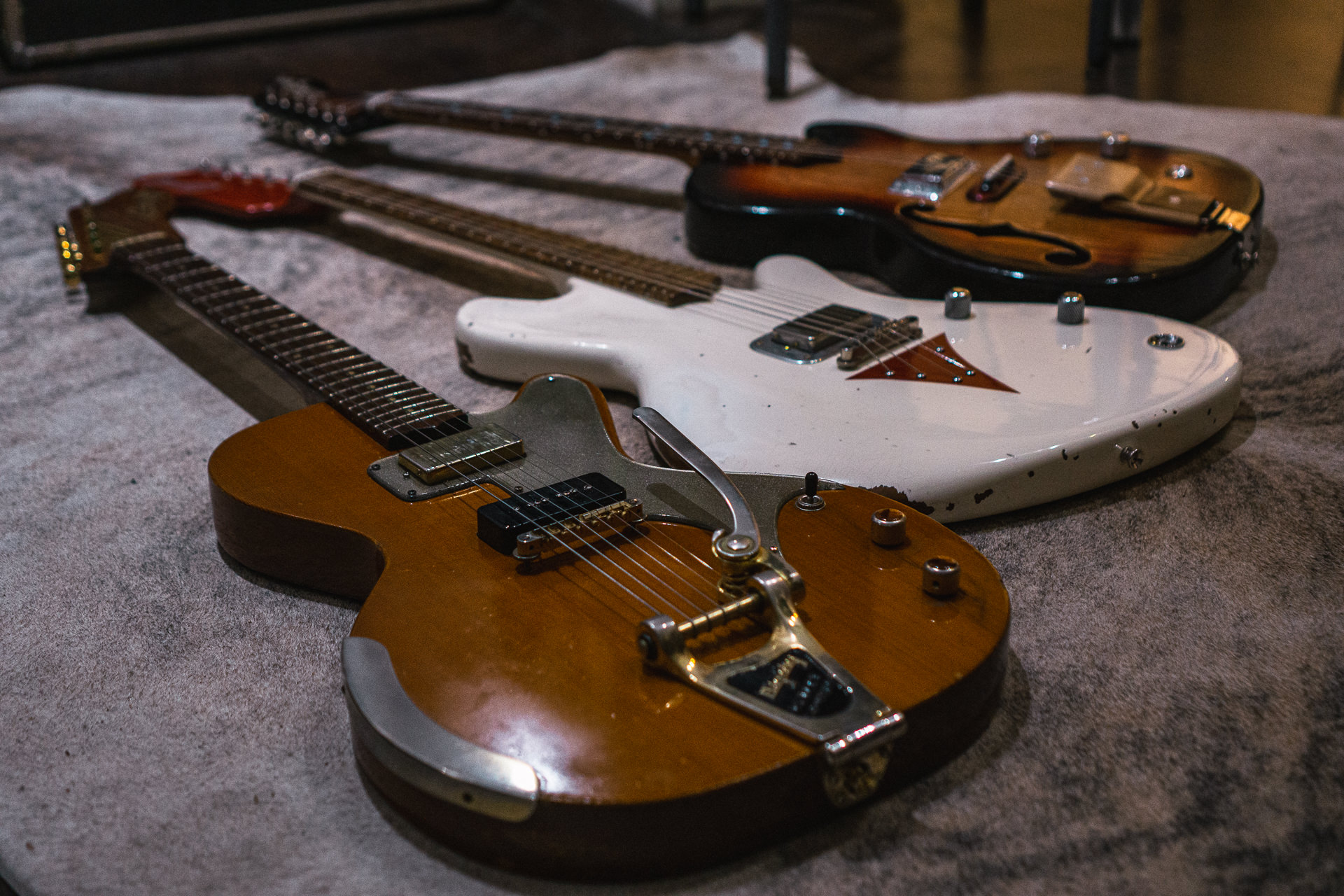

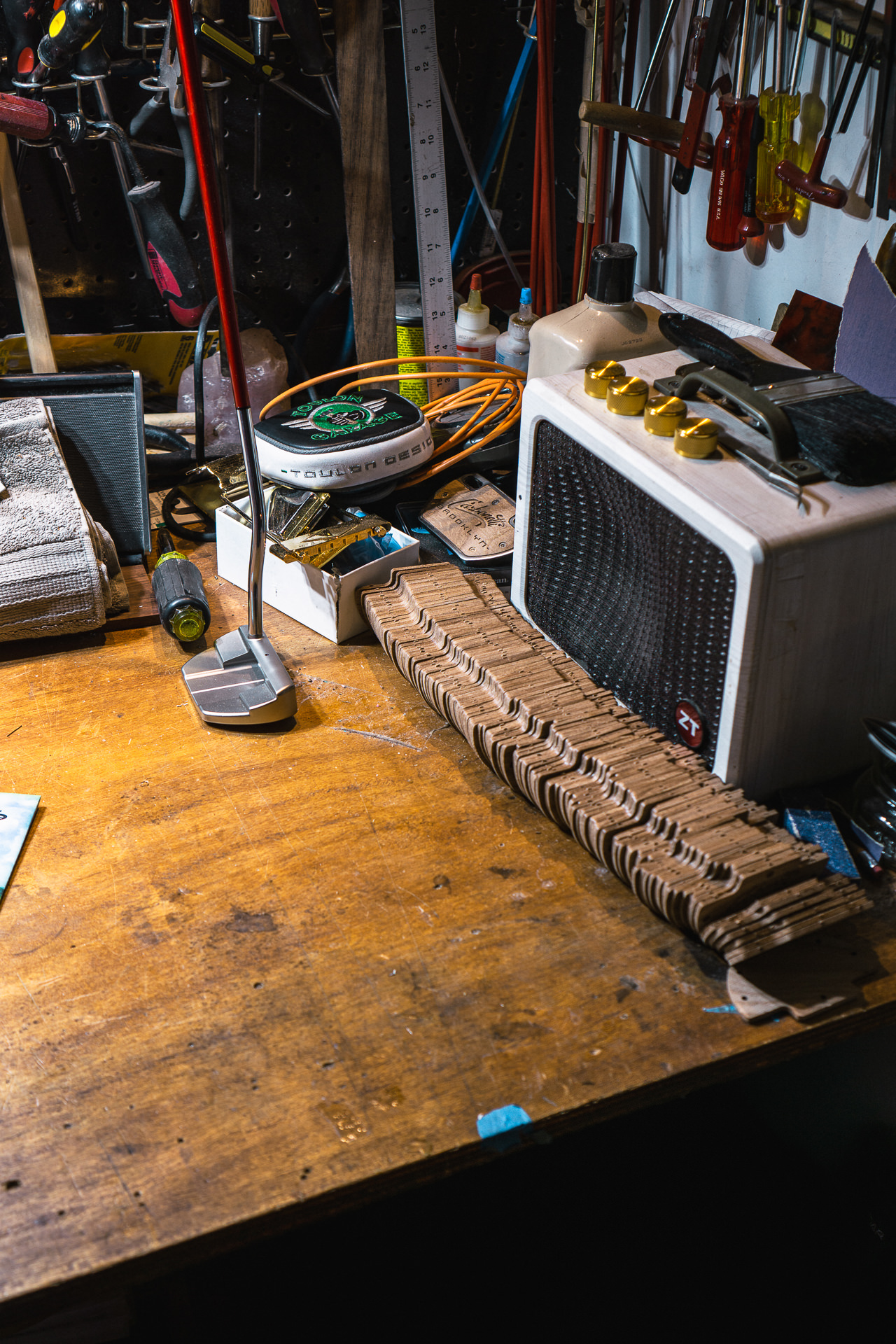
Who are some notable people that are playing Carbonetti guitars?
We have Richard Fortis from Guns N’ Roses, and he and I designed the Moon Phase model together. My buddy Dan Iead, who plays with Norah Jones, uses a really cool hollow-body lap steel I made him. I did a Bo Diddley Gretsch-style guitar for producer and guitarist Matt Sweeney, and I’ve done some stuff for Rich Robinson of the Black Crowes. I’m freaked out and proud that players like these guys use my guitars and really work ‘em.
You spent a lot of time handling rare vintage guitars at Chelsea Guitars. How did that experience shape your work as a builder?
I really hold that accountable for why my guitars are so good. I’ve owned and played some of the craziest and most sought after vintage guitars because I worked at vintage shops for so long and I had great bosses that gave me guitars at cost. I was working at these shops from 2004 to 2010, so I just had some of the craziest vintage guitars back when Les Paul Juniors were still $1800, and then all of a sudden they’re hitting five grand and I’m priced out. So just getting to fix all those old guitars and own them and dissect them and feel them, and actually tour with them with my band Caveman really shaped my builds. That’s why the guitars I make feel and sound the way they do. The truth is with vintage guitars, nobody really knows what these things are like until they actually feel and play them! Most people don’t actually know what a ‘59 Les Paul neck feels like, they know what a reissue ‘59 neck feels like or what Gibson’s marketing department says a ‘59 neck is like, and it’s usually much further away from the real deal than most realize.
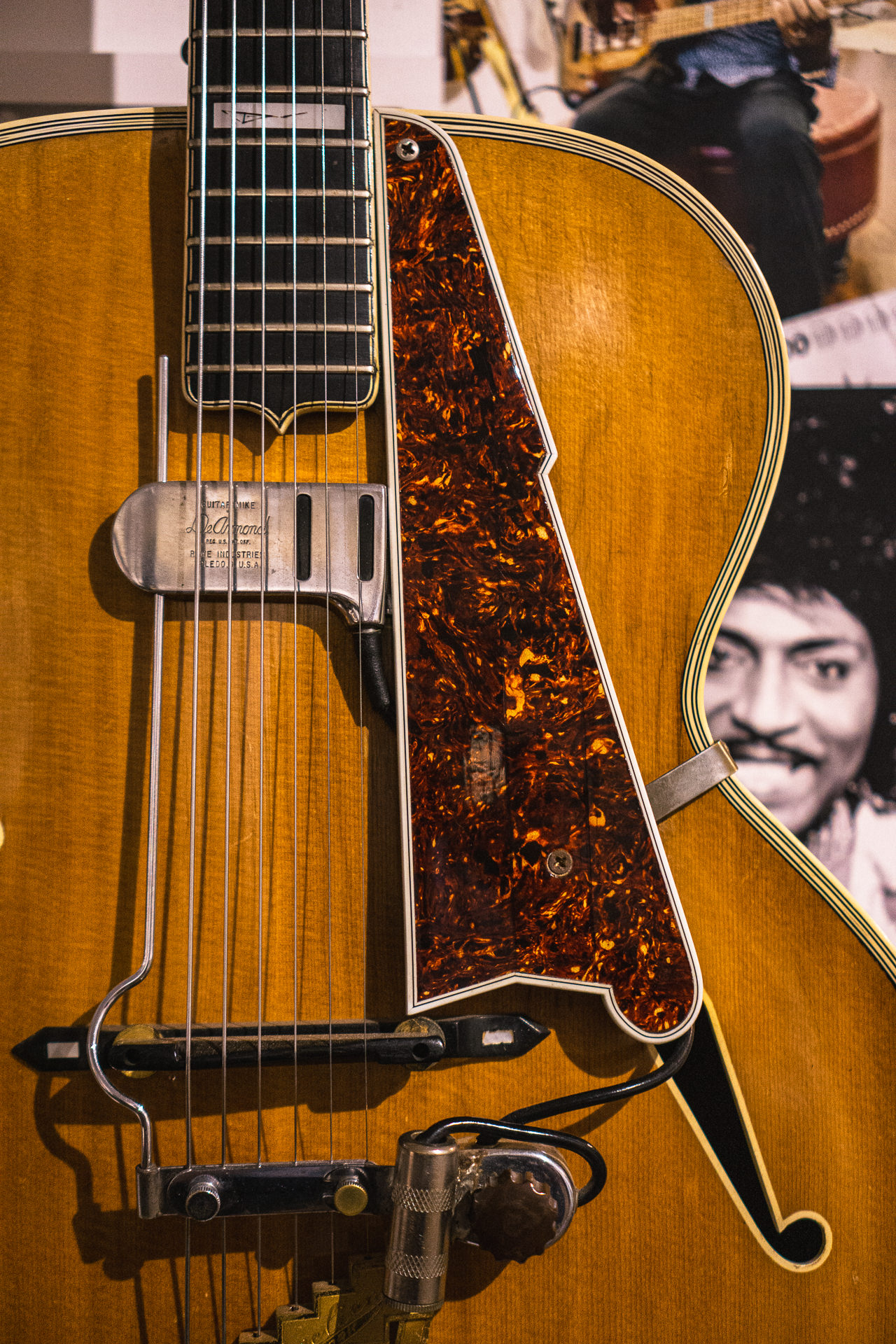
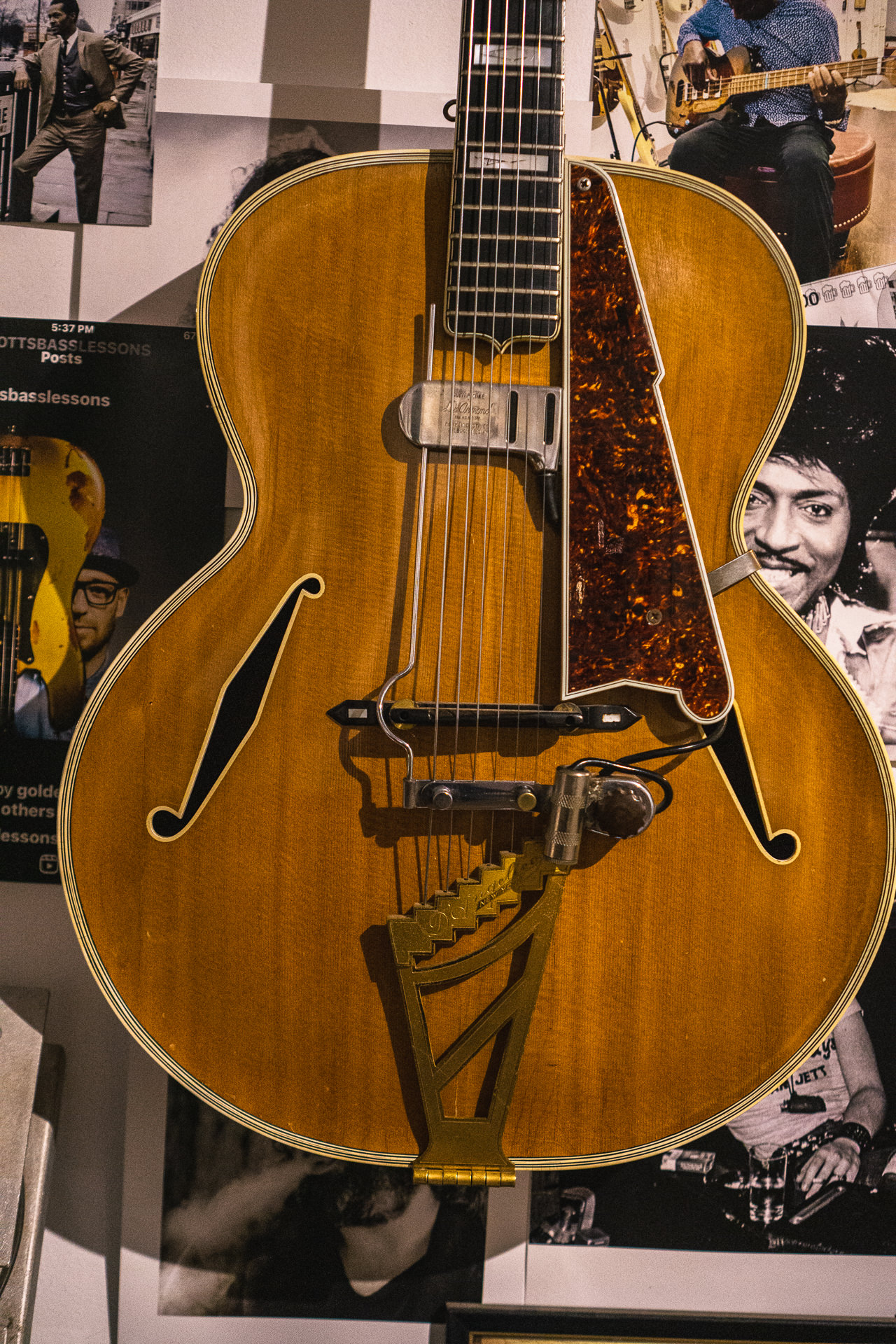
Speaking of guitars most people have never handled, tell me how your stunning D’Angelico Excel came into your life and its influence on your builds.
Growing up in New York City as a young luthier, especially an Italian-American one, you have to look at John D’Angelico’s work. You have to look at what he did and how he did it, and how special each one of his guitars were. Each one was one-of-a-kind; if you put 10 of ’em next to each other – even if they’re all the same model – there’s just these little things that are very personal because each one was made for somebody. That’s how my guitar life has been building with the Carbonetti guitars.
Each one I make is for somebody, there’s no production line or guitars that I just build on a whim. They’re all going to be completely different and that’s something John D’Angelico’s influence gave me. I think the real inspiration D’Angelico gave came from him having the balls to literally make everything on his guitars by hand. His guitars are this secret club of “if you know, you know” and they were special for each owner and it’s always been my dream to facilitate an insider thing like that. It’s why I’ve never had a street-front spot or sought out the Guitar Center crowd. The best of everything in New York City is like that, where if you know, you know, and if not, you need to be brought in.
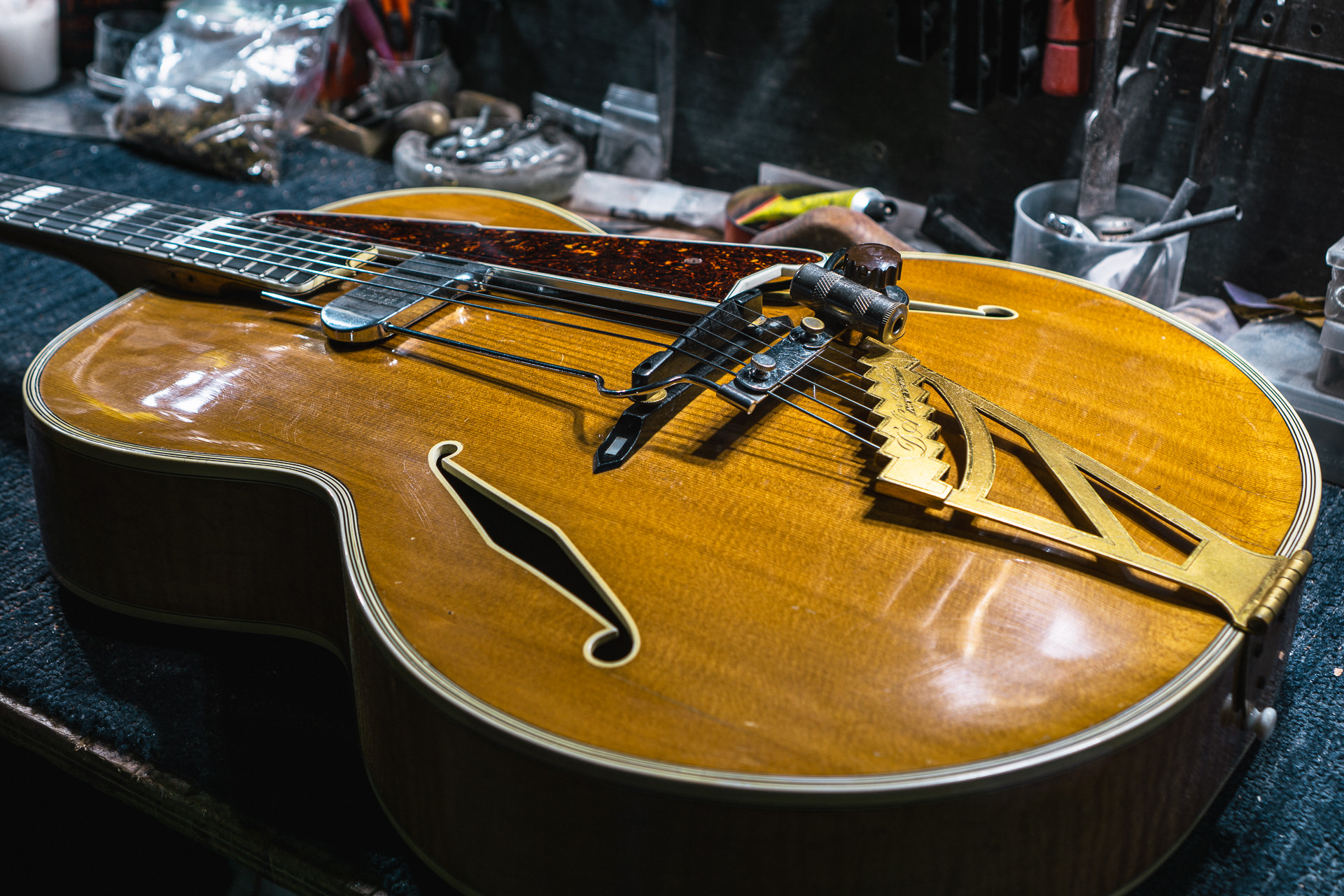
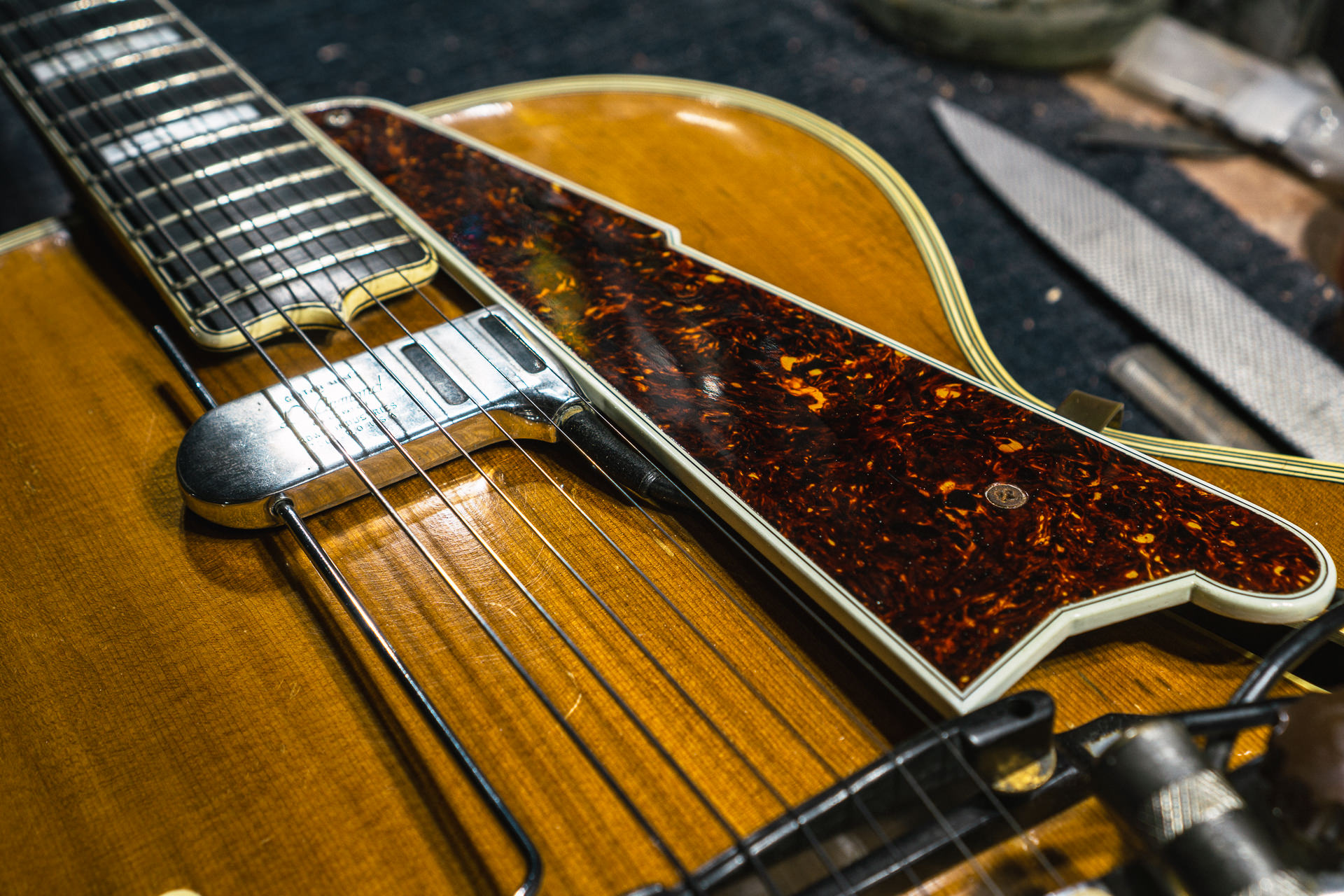
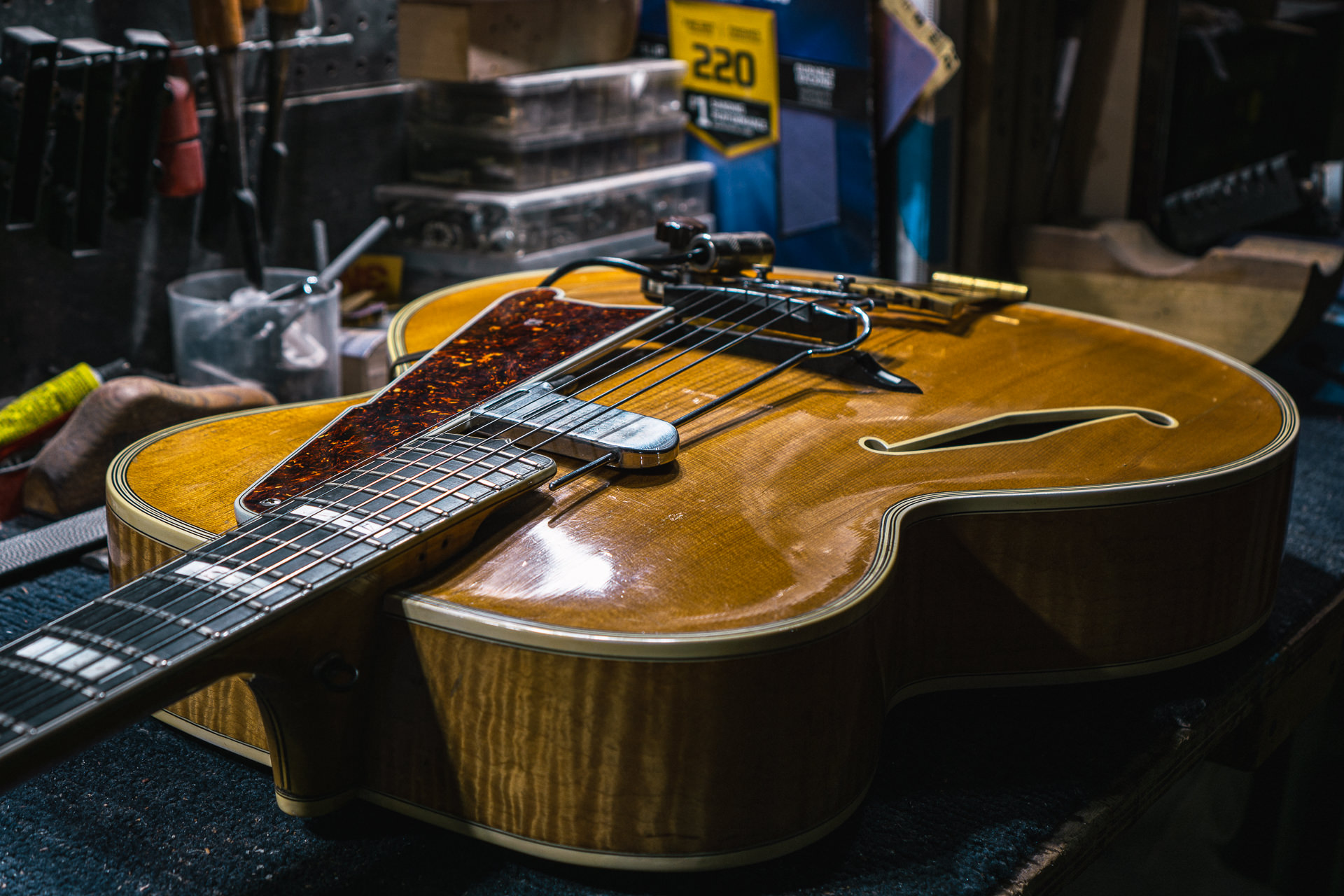
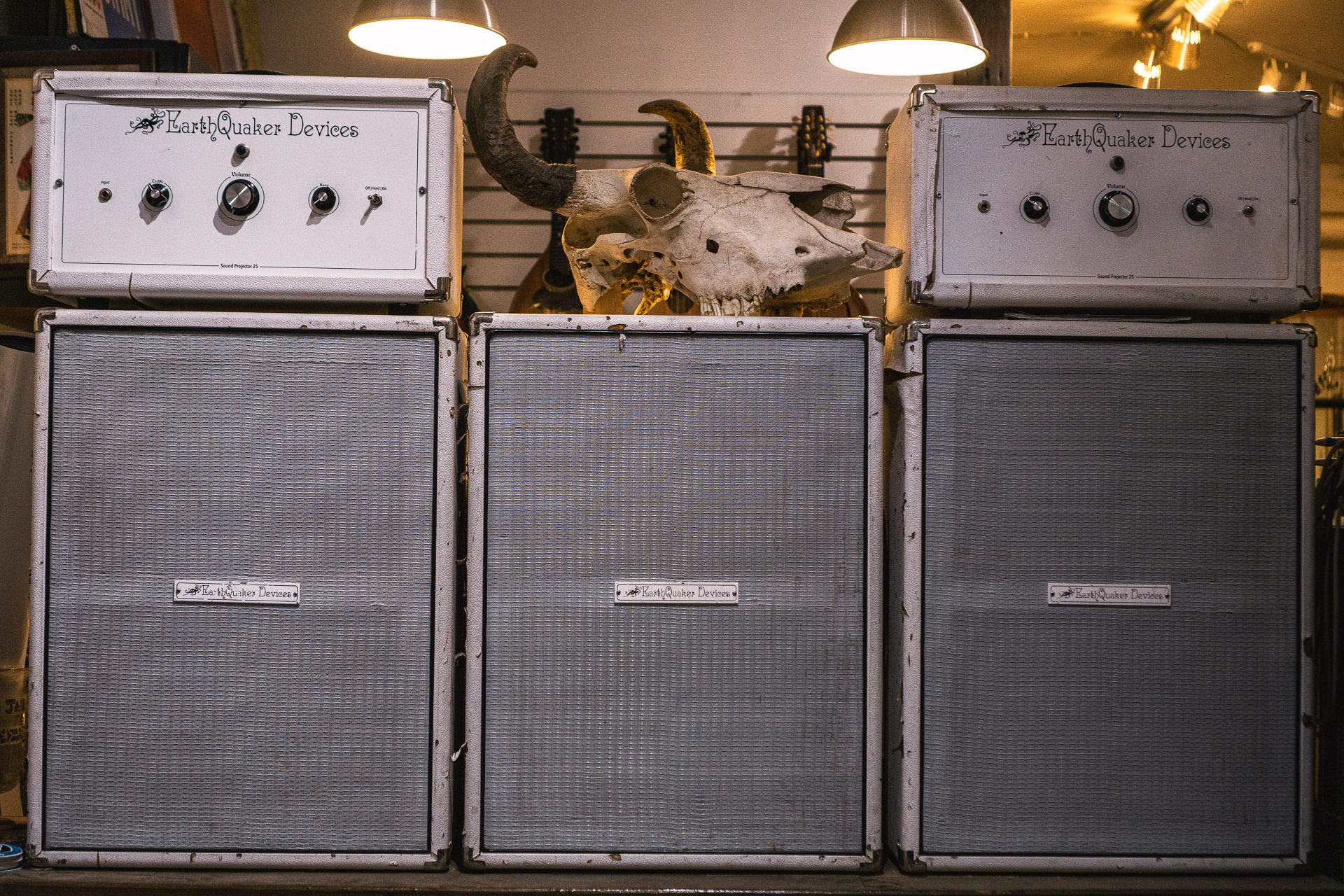
There’s a similar love of the “insider appeal” in watch collecting, where it might not be obvious that a piece is something special or unique to most, but is actually a sought after rarity.
I feel like guitars and watches are the same in many ways. It’s the same passion and they give you that same feeling when you find the right one. They make you stand taller and you feel fucking cool. The right guitar and the right watch can both make you feel like a champ and help you express yourself. And they usually have stories, too. You can see the life a watch has lived pretty easily.
How did you take ownership of your D’Angelico Excel? I’ve heard it’s quite the story.
I became absolutely obsessed with D’Angelicos through Danny when I was at Chelsea guitars, but couldn’t afford one at the time. Many years later, my 1938 Excel came into my life through Danny: He got it from the owner’s sister and it was originally ordered by James “Jimmy Nap” Napoli, a renowned Brooklyn mobster and a capo in the Genovese family. It was finished on 3/31/1938 and we don’t know if he played it, it was a gift for someone, or maybe he was moving dirty money around – but it was his name on the original order. The whole NYC guitar shop community knew that a D’Angelico Excel was my grail guitar and a lot of people came together to help me get it because I had to sell most of my guitars to make it happen, so there was a lot of deals happening and people trying to help facilitate it – which was beautiful. When I got the guitar, the neck was off the body. Danny brought the guitar to show it to me and I said “I’m taking it as is! Don’t fucking touch it! Give me the right price!” So because he didn’t have to repair it, I got it more than half off. It was still the most expensive thing I’d ever bought.
What we think happened was maybe Jimmy D’Aquisto [John D’Angelico’s apprentice] was doing a neck set on it and passed away, because the neck was taken out of the pocket perfectly. It wasn’t broken, it was obviously done by a pro that knew these guitars. So it was either him or Carlo Greco, because Carlo made the pickguard it wears years after the guitar was originally built. So it got put in the case and wasn’t touched again for ages. So beyond just being my dream guitar, it’s a story guitar! Between its provenance with Jimmy Nap and trying to figure out the backstory on the neck removal, it has everything I love in a guitar.
Tell me about putting it back together. That must’ve been nerve-wracking!
A luthier named Ric McCurdy and I put it back together because he’s a master archtop builder. We did it during the craziest lightning storm I’d ever seen, and we were here at night and all we had to do was apply one big clamp – just fit the neck and glue it in. It was exactly like Frankenstein and a lightning bolt hit the fucking building and shook it as the clamp was being turned! It was like the ghost of Jimmy D’Angelico was visiting the guitar and breathing life back into it or something!
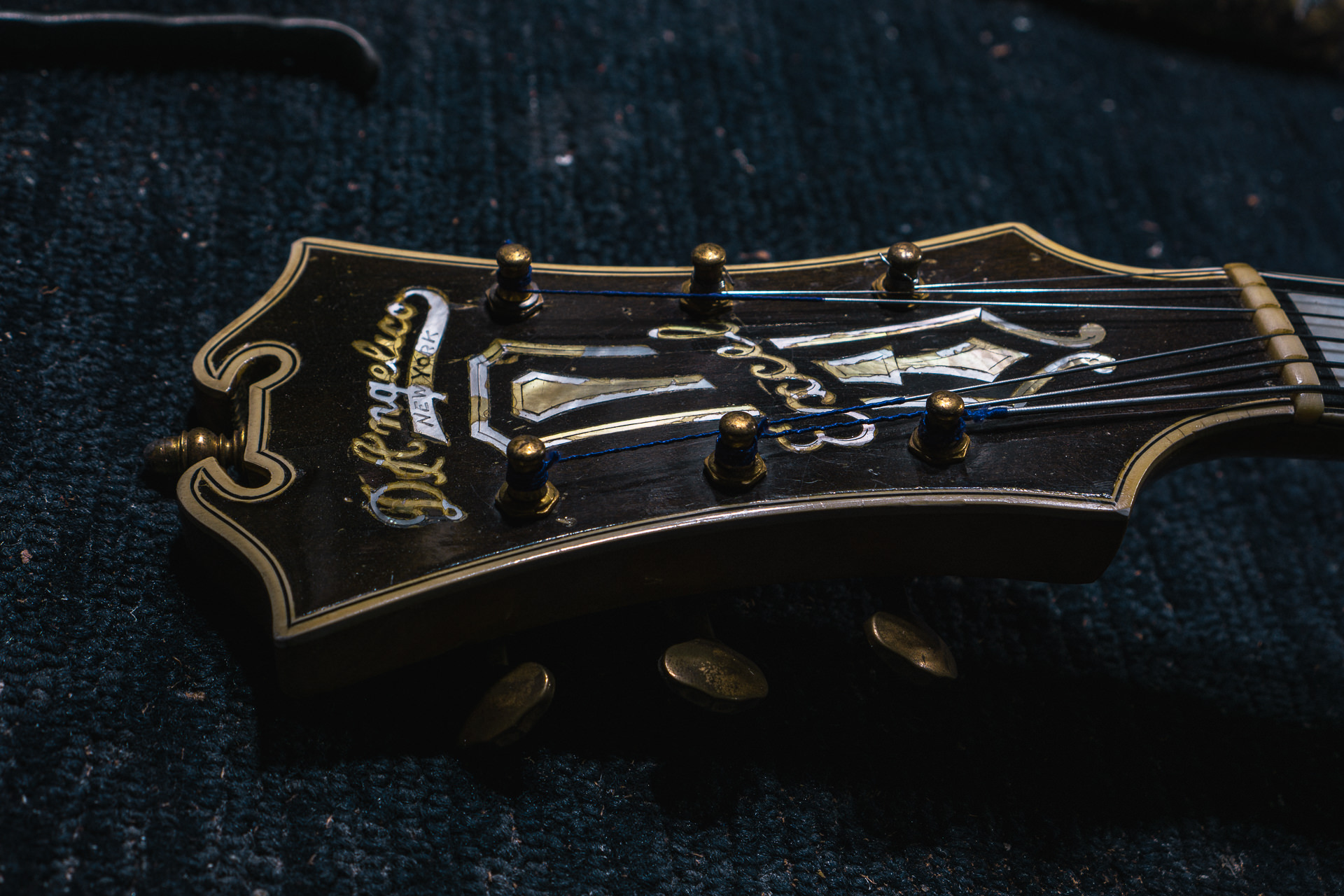
What’s it like actually living with that guitar now?
I feel like it stepped up my building because I got to open it up and really go through it during the neck set. It’s like having a 3-D blueprint to look at and it was a really rare chance to see how D’Angelico built these things from the inside out.
How did you get into Rolex? I know you wear your ‘80s GMT-Master when you work.
I sleep in it. I never take it off. The only time I take it off is when I’m painting guitars; I wear it while I use the belt-sander – everything. I actually got into watches through vintage guitars! I’d hear these old stories from Danny at Chelsea that he’d wear a Rolex or a nice watch because he’d often been able to close the deal on a ‘58 Strat or something when he was a few bucks short with a watch. It’s a backup plan without cash. So Danny and Chris Cush from Mojo Guitar Shop and Headless Horseman got me into Rolex. Rolexes have the same thing as guitars, with stories and lives lived, and I love things that have a function and have a reason for being.
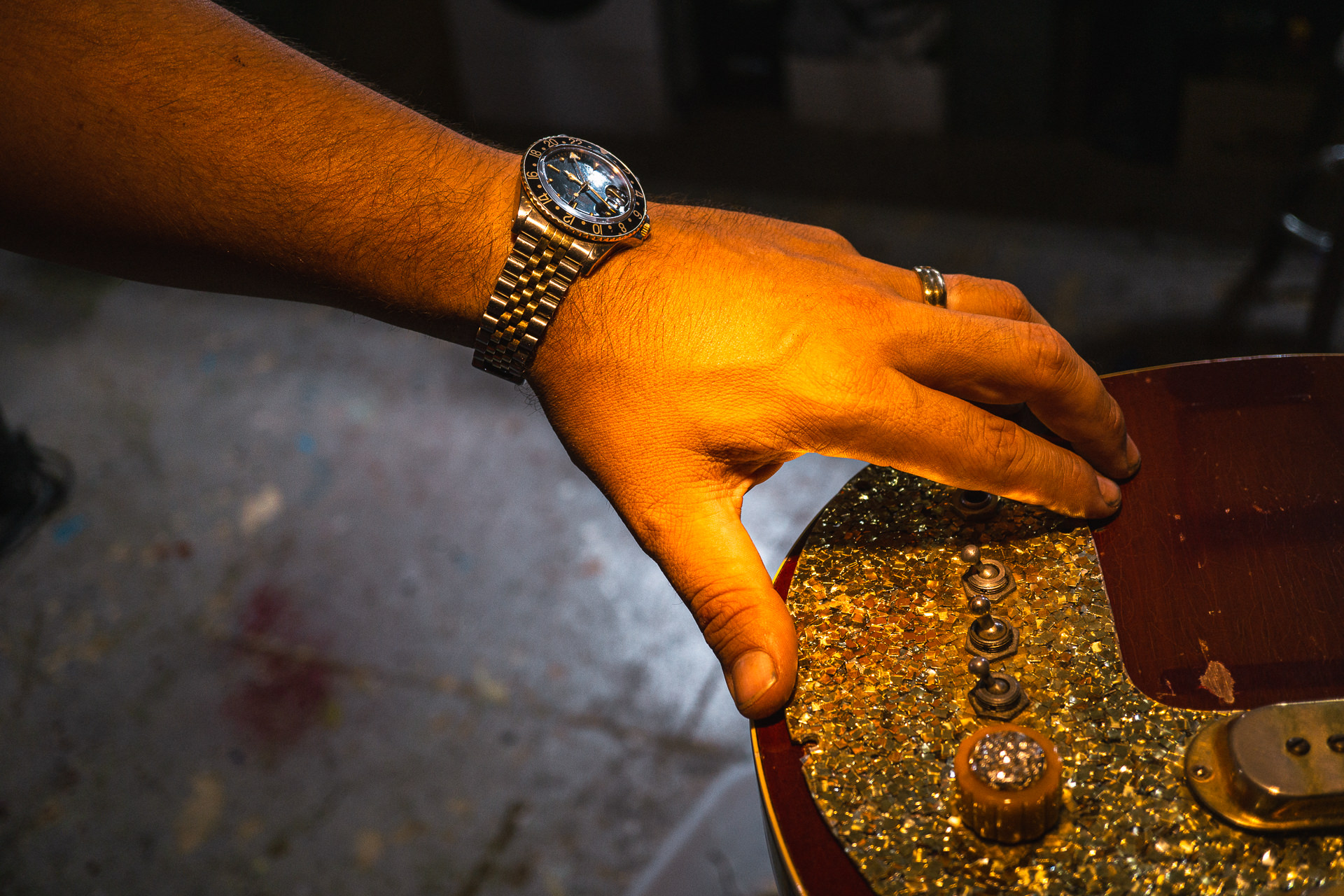
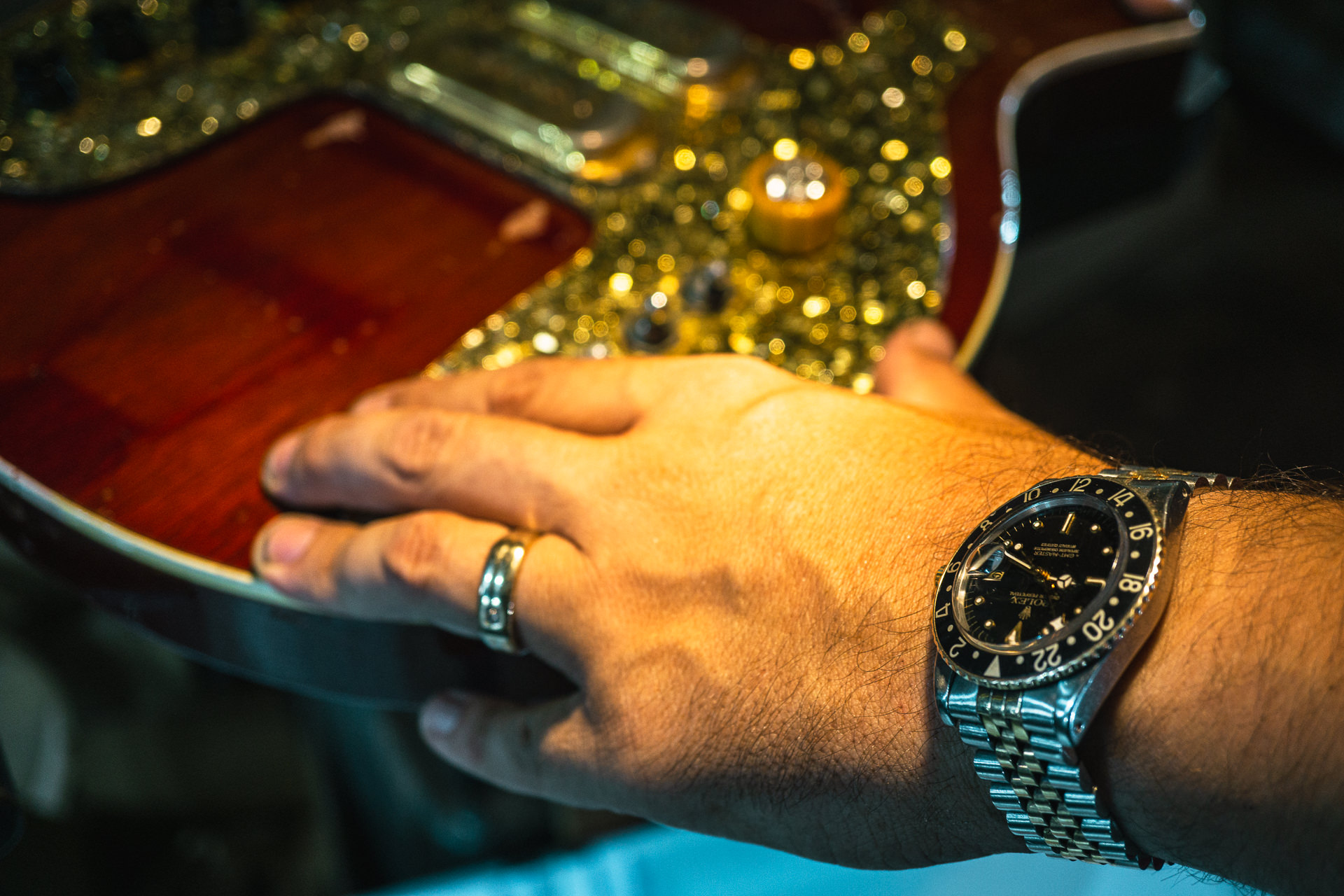
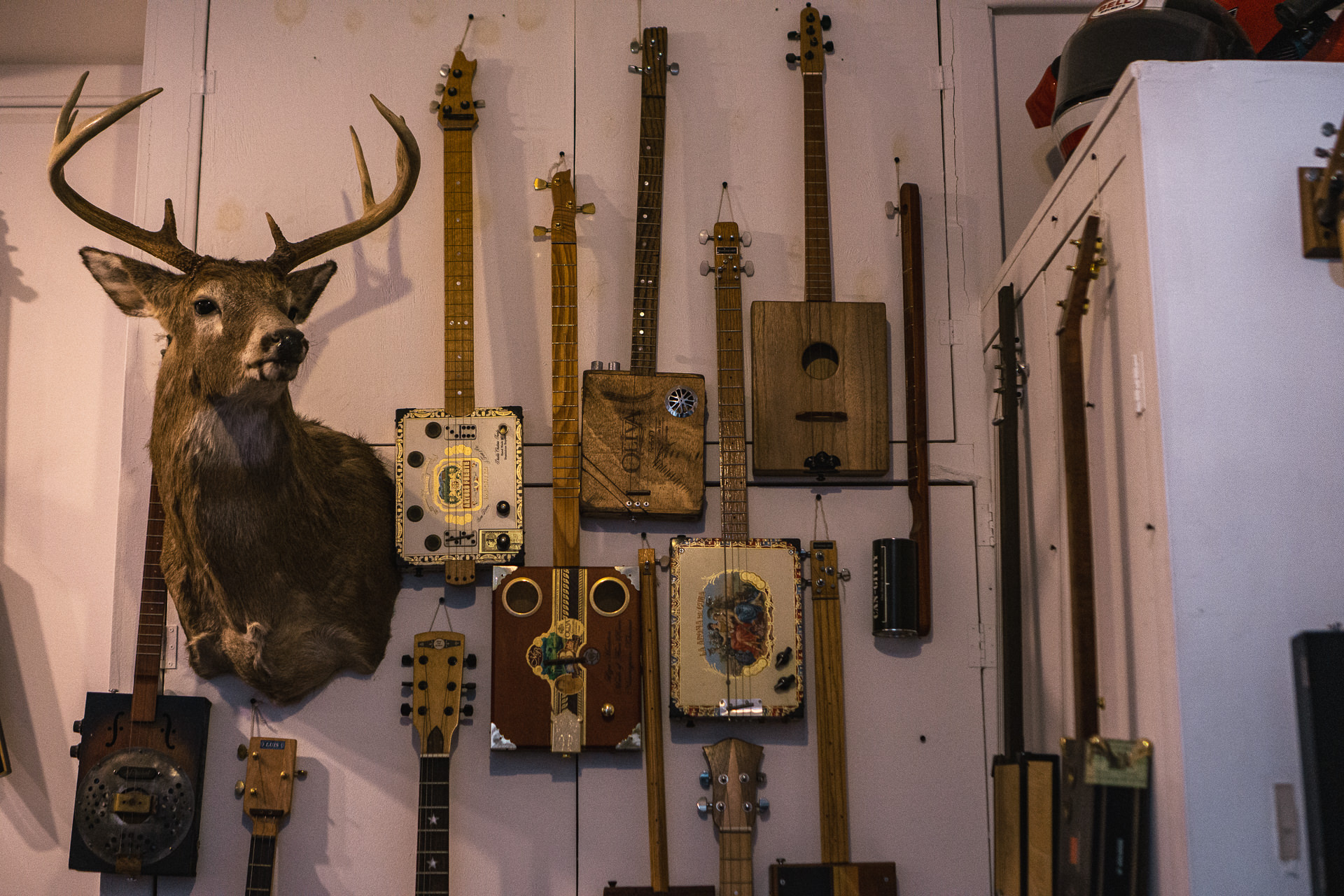
How did you end up with your 1980 GMT-Master? What’s the story with it?
I’ve always loved the look of black and gold stuff. I was fully obsessed with watches and I had sold my buddy and local guy Macaulay Culkin a bass. I didn’t have any real money at the time, but I was like “I’m taking this money and I’m buying a Rolex!” This was in 2015 and I found a nice GMT. I really wanted an ‘86 because it’s my birth year. So I got that one, which had the standard lume plots, for $5k and wore it for a year and needed dough at one point and had to let it go. So like the guitar dealers explained, a Rolex is the best insurance and I sold it a year later and made money.
I missed that ‘86 GMT so much that I said “I need another one someday” and I had gotten deeper into the details that make GMT-Masters from that era so cool and I found out about the “nipple” dial ones. I thought it was so cool how they look like stones when they catch the light under the crystal. My wife Sarah and I were getting married during COVID and an infection scare broke up the wedding at the last minute. We had to cancel everything; we had rented a really cool art deco house upstate for it. So we were on line to get COVID tests, annoyed and sad because this was still early on before vaccines and it was potentially really bad. Sarah was like “How about we just cancel everything, get our deposits back and get a couple really nice Rolexes for our wedding?” I was like “That’s why I married you!” So we went on the hunt to get our dream watches (within reason, obviously). The GMT I ended up with is a 1980 “nipple” dial model on its original Jubilee bracelet, and it means so much more now than an insurance plan. You get those things that fall into your life that you know you’ll keep forever – it’s a lifer. These are like bigger wedding rings for us.That said, my ultimate dream Rolex is an all gold GMT-Master from the same era.
Sarah didn’t know what she wanted because she was not a watch person yet, so it was really fun going through options with her and figuring out her taste. She ended up with a gold ladies Datejust with a walnut exotic dial, it’s a ‘79.

Golf is a big part of your personal life and has recently become a part of the Carbonetti Guitars business through your collaboration with Toulon on a series of limited edition putters. How did that unexpected collaboration take shape?
My grandmother taught me golf and I caddied for her before I ever swung a club. She was really good, and my grandfather was a scratch golfer. So it was always on my mom’s side of the family and in the summer, I’d go to golf camp – but then I picked up a guitar and didn’t give a shit about anything else for a long, long time. I’d play golf 3 times a year with my uncles – stoned and drunk – but I didn’t care about the score or anything, just having a laugh. But Sarah played in college, so we started playing together and I really got into understanding the game again and improving. This happened in the middle of COVID and once the golf courses started opening back up, I realized that it was satisfying the same side of my brain as playing music and touring – which I was missing through COVID. It was that same feeling of challenging yourself to get better and learn.
While rediscovering my love of golf, I was introduced to Tony Toulon, who is Sean Toulon’s son. Tony is a guitar player and a great dude, and his grandfather was a Porsche race car driver named Vern Toulon. Sean ran TaylorMade for years and then retired, but started Toulon with his sons Tony and Joe. Toulon eventually got brought in by Callaway to run Odyssey and around the same time, Tony and were talking and I was like “Let’s collaborate on something.” We got really close and it was like instant family, and we started really mixing up ideas – fun things using my woodworking skills and special trees from important locations. I popped the collab question and they were immediately into it, and the clubs were in production almost immediately. It happened incredibly fast and naturally.
The first batch of collaboration putters have been a massive success. The first run sold out immediately. It’s based on the Toulon Memphis model, but the Carbonetti putter features my color choice and feel, and then I make the wood plate on the bottom out of maple. It was an amazing experience figuring out how to make that wood perfect and waterproof so people can really use them and not worry about things like the morning dew or some rain ruining the club. We have to CNC the wood plates so they’re perfect, and I had to figure out the amount of swelling the wood needed to be able to fit perfectly when it expands after getting wet. We even picked the type of steel used and the finishing of it. We made 25 for the first run and they sold out in under five minutes; two PGA Tour guys have them in their bags and so does Pat Carney from the Black Keys! Toulon was actually more excited that I got Pat a putter than the two PGA guys! All the Toulon guys want to talk about is music and guitars and all I want to talk about is golf and watches! It’s been a really organic, very natural relationship.
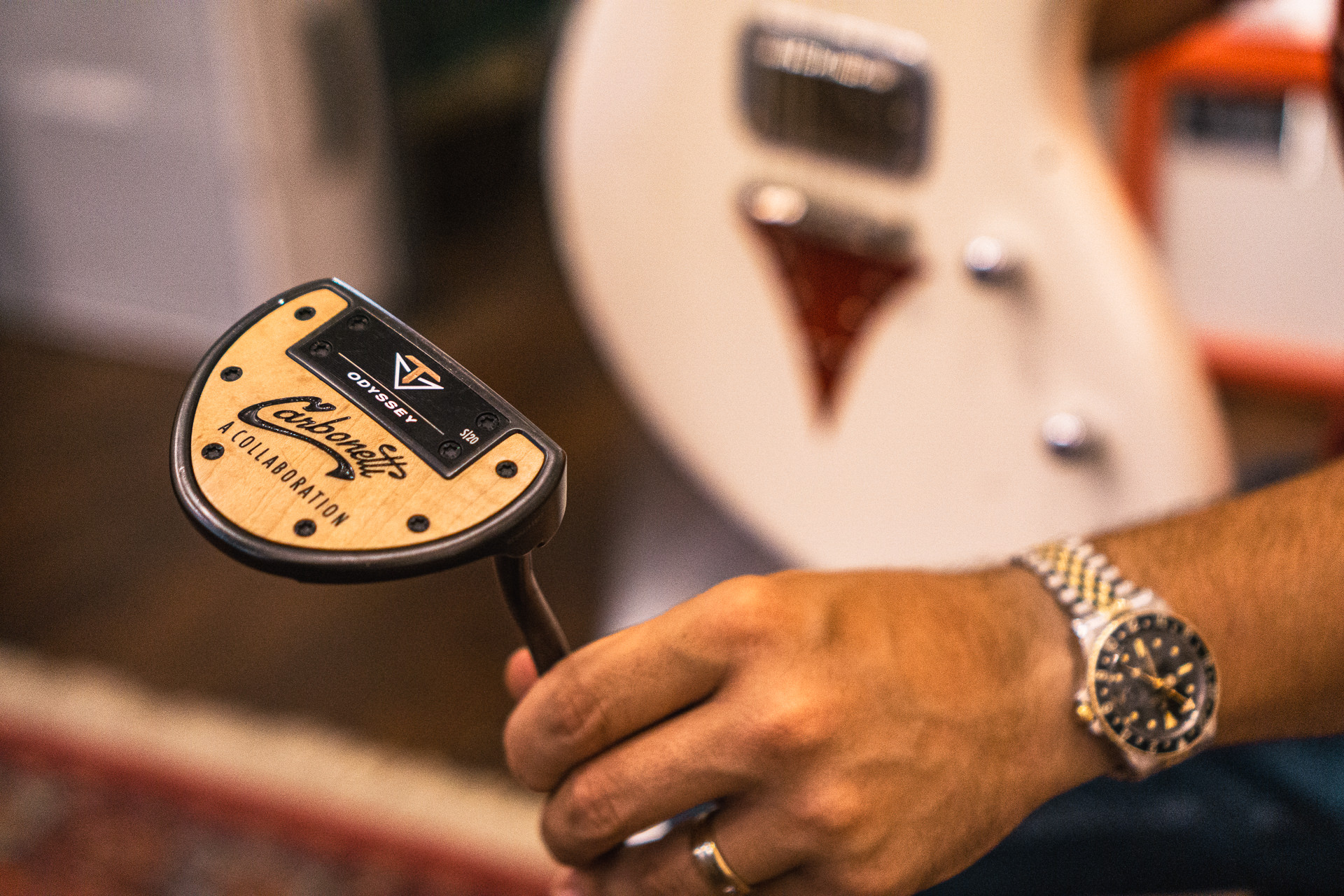
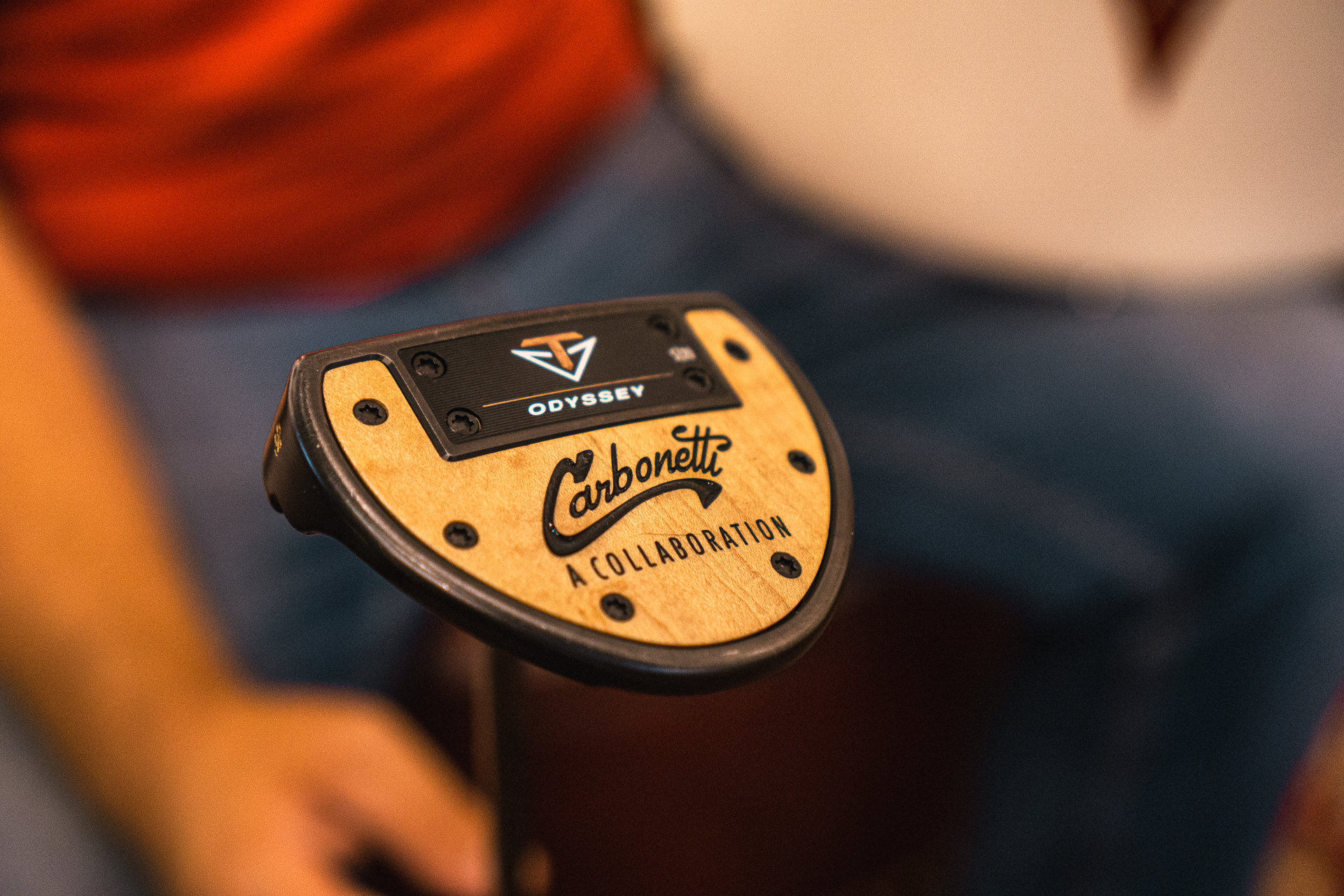
Explain the appeal of the Carbonetti/Toulon putter to the layman. How does it relate to your guitars philosophically?
It brings a touch of organic material that used to be present in all golf clubs, and most brands wouldn’t ever think to put wood on a golf club anymore. I think these clubs are a really cool way to look to the past that uses an organic touch. Just like an old guitar, there’s more to the story of this putter now. The new putter we’re doing together uses special wood from a special place that’s a secret for now, but we’re also doing a guitar with it to match the vibe, and it’s gonna be a really cool release that we’re auctioning off. Yeah. There’s a really cool story behind where the wood came from and like what it actually is. I didn’t just go to Home Depot to get some wood. Everything I do has to tie back into that story aspect, and to me, that’s what makes you feel something. It’s about inspiration and feeling inspired when you pick something up; it’s the same thing we get from putting on a watch. I really just love bringing an organic touch to a world that’s become as tech-focused as golf equipment – to give the club a centerpiece. A good analog is the wood-dial Rolexes got their walnut from the Rolls Royce factory; to add an organic element to something as perfectly engineered as a Rolex makes it something else.
Everything I make comes with the goal that it hopefully lives a life and they look like someone cared about them, but enjoyed them someday many, many years from now. I want to make things that make people feel confident, whether they’re on the PGA Tour or on stage in front of 10,000 people, you’ll have the best tool available in your hands. Hopefully it brings out the best in you.
Visit Carbonetti Guitars on IG at @carbonettiguitars and online at https://carbonettiguitars.com/
Check out Caveman’s music at https://www.cavemantheband.com/ and on Instragram at @cavemanband

Check out 'Reference Tracks' our Spotify playlist. We’ll take you through what’s been spinning on the black circle at the C + T offices.

Never miss a watch. Get push notifications for new items and content as well as exclusive access to app only product launches.
Sign up for our newsletter to receive updates and exclusive offers